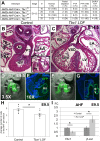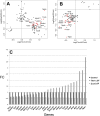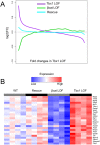Reduced dosage of β-catenin provides significant rescue of cardiac outflow tract anomalies in a Tbx1 conditional null mouse model of 22q11.2 deletion syndrome
- PMID: 28346476
- PMCID: PMC5386301
- DOI: 10.1371/journal.pgen.1006687
Reduced dosage of β-catenin provides significant rescue of cardiac outflow tract anomalies in a Tbx1 conditional null mouse model of 22q11.2 deletion syndrome
Abstract
The 22q11.2 deletion syndrome (22q11.2DS; velo-cardio-facial syndrome; DiGeorge syndrome) is a congenital anomaly disorder in which haploinsufficiency of TBX1, encoding a T-box transcription factor, is the major candidate for cardiac outflow tract (OFT) malformations. Inactivation of Tbx1 in the anterior heart field (AHF) mesoderm in the mouse results in premature expression of pro-differentiation genes and a persistent truncus arteriosus (PTA) in which septation does not form between the aorta and pulmonary trunk. Canonical Wnt/β-catenin has major roles in cardiac OFT development that may act upstream of Tbx1. Consistent with an antagonistic relationship, we found the opposite gene expression changes occurred in the AHF in β-catenin loss of function embryos compared to Tbx1 loss of function embryos, providing an opportunity to test for genetic rescue. When both alleles of Tbx1 and one allele of β-catenin were inactivated in the Mef2c-AHF-Cre domain, 61% of them (n = 34) showed partial or complete rescue of the PTA defect. Upregulated genes that were oppositely changed in expression in individual mutant embryos were normalized in significantly rescued embryos. Further, β-catenin was increased in expression when Tbx1 was inactivated, suggesting that there may be a negative feedback loop between canonical Wnt and Tbx1 in the AHF to allow the formation of the OFT. We suggest that alteration of this balance may contribute to variable expressivity in 22q11.2DS.
Conflict of interest statement
The authors have declared that no competing interests exist.
Figures







Similar articles
-
Dysregulation of TBX1 dosage in the anterior heart field results in congenital heart disease resembling the 22q11.2 duplication syndrome.Hum Mol Genet. 2018 Jun 1;27(11):1847-1857. doi: 10.1093/hmg/ddy078. Hum Mol Genet. 2018. PMID: 29509905 Free PMC article.
-
Beta-catenin deficiency causes DiGeorge syndrome-like phenotypes through regulation of Tbx1.Development. 2010 Apr;137(7):1137-47. doi: 10.1242/dev.045534. Development. 2010. PMID: 20215350 Free PMC article.
-
Loss of CXCL12/CXCR4 signalling impacts several aspects of cardiovascular development but does not exacerbate Tbx1 haploinsufficiency.PLoS One. 2018 Nov 8;13(11):e0207251. doi: 10.1371/journal.pone.0207251. eCollection 2018. PLoS One. 2018. PMID: 30408103 Free PMC article.
-
22q11 deletion syndrome: a role for TBX1 in pharyngeal and cardiovascular development.Pediatr Cardiol. 2010 Apr;31(3):378-90. doi: 10.1007/s00246-009-9613-0. Pediatr Cardiol. 2010. PMID: 20054531 Review.
-
Understanding the role of Tbx1 as a candidate gene for 22q11.2 deletion syndrome.Curr Allergy Asthma Rep. 2013 Dec;13(6):613-21. doi: 10.1007/s11882-013-0384-6. Curr Allergy Asthma Rep. 2013. PMID: 23996541 Free PMC article. Review.
Cited by
-
Variants in a cis-regulatory element of TBX1 in conotruncal heart defect patients impair GATA6-mediated transactivation.Orphanet J Rare Dis. 2021 Jul 31;16(1):334. doi: 10.1186/s13023-021-01981-4. Orphanet J Rare Dis. 2021. PMID: 34332615 Free PMC article.
-
Genome-Wide Association Study to Find Modifiers for Tetralogy of Fallot in the 22q11.2 Deletion Syndrome Identifies Variants in the GPR98 Locus on 5q14.3.Circ Cardiovasc Genet. 2017 Oct;10(5):e001690. doi: 10.1161/CIRCGENETICS.116.001690. Circ Cardiovasc Genet. 2017. PMID: 29025761 Free PMC article.
-
Molecular Pathways and Animal Models of Truncus Arteriosus.Adv Exp Med Biol. 2024;1441:853-865. doi: 10.1007/978-3-031-44087-8_52. Adv Exp Med Biol. 2024. PMID: 38884754 Review.
-
Long Noncoding RNA lnc-TSSK2-8 Activates Canonical Wnt/β-Catenin Signaling Through Small Heat Shock Proteins HSPA6 and CRYAB.Front Cell Dev Biol. 2021 May 10;9:660576. doi: 10.3389/fcell.2021.660576. eCollection 2021. Front Cell Dev Biol. 2021. PMID: 34041241 Free PMC article.
-
Dysregulation of TBX1 dosage in the anterior heart field results in congenital heart disease resembling the 22q11.2 duplication syndrome.Hum Mol Genet. 2018 Jun 1;27(11):1847-1857. doi: 10.1093/hmg/ddy078. Hum Mol Genet. 2018. PMID: 29509905 Free PMC article.
References
-
- Burn J, Goodship J. Developmental genetics of the heart. Curr Opin Genet Dev. 1996;6(3):322–5. - PubMed
Publication types
MeSH terms
Substances
Grants and funding
LinkOut - more resources
Full Text Sources
Other Literature Sources
Molecular Biology Databases

